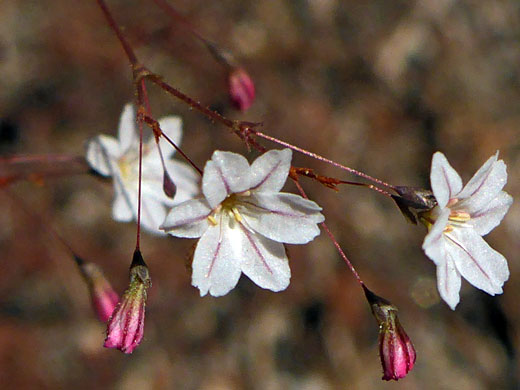Common name:
Spurry buckwheat
Family:
Scientific name:
Eriogonum spergulinum
Main flower color:
Range:
California, Oregon, south Idaho and west Nevada
Height:
Up to 16 inches
Habitat:
Meadows, woodland, sagebrush, sandy or rocky slopes, in mountainous areas; from 4,000 to 11,500 feet
Leaves:
Linear, up to 1.3 inches long
Season:
to
The thin, reddish to gray stems of eriogonum spergulinum may be glabrous or sparsely glandular. Stems may lay along the ground or angle upwards, to heights of 4 to 16 inches. Leaves grow at the base and along the stems; all are similar in appearance; linear, around one inch long, with ciliate margins, often slightly rolled under.
The inflorescence is an open, branched cluster, up to 10 inches tall and 14 inches wide, the branches sparsely hairy, and glandular. The narrow involucres have four apical teeth, and are attached by very narrow, hair-like stalks. Flowers have six oblong tepals, white to pale pink, darker along the midvein.
There are three varieties of eriogonum spergulinum: least widespread, restricted to the southern Sierra Nevada, is var pratense, for which the inflorescence branches are non glandular, and the plant prostrate. The other two varieties have glandular inflorescence branches, and erect stems: var reddingianum for which the flowers are less than 0.1 inch in length, and var reddingianum for which the flowers are more than 0.1 inch in length.
The inflorescence is an open, branched cluster, up to 10 inches tall and 14 inches wide, the branches sparsely hairy, and glandular. The narrow involucres have four apical teeth, and are attached by very narrow, hair-like stalks. Flowers have six oblong tepals, white to pale pink, darker along the midvein.
There are three varieties of eriogonum spergulinum: least widespread, restricted to the southern Sierra Nevada, is var pratense, for which the inflorescence branches are non glandular, and the plant prostrate. The other two varieties have glandular inflorescence branches, and erect stems: var reddingianum for which the flowers are less than 0.1 inch in length, and var reddingianum for which the flowers are more than 0.1 inch in length.
All Contents © Copyright The American Southwest | Comments and Questions | Contribute | Site Map


